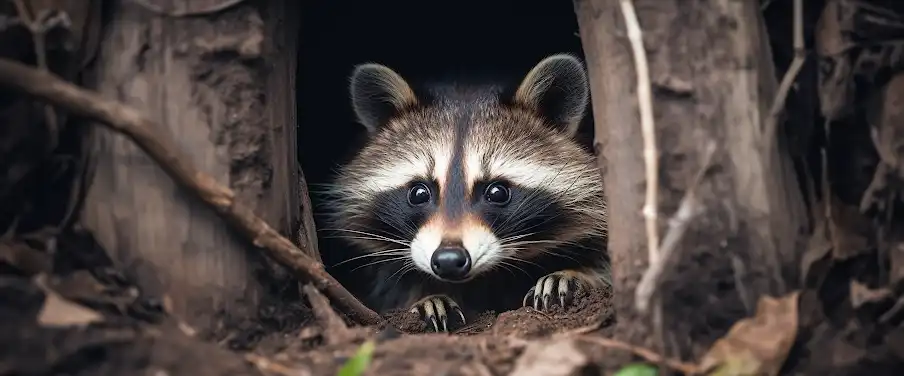
Raccoons: those mysterious creatures of the night. These ring-tailed ruffians, known scientifically as Procyon Lotor, are found in almost every corner of the United States. They’re particularly notorious in Central Florida for their mischievous antics under the cover of darkness.
So what exactly do raccoons, these quintessential North American explorers, get up to when the sun dips below the horizon? Well, suffice to say, their nightly occupations are diverse and nothing short of fascinating. From scavenging through garbage bins to scaling trees gracefully, these nocturnal critters are renowned for their resourcefulness and dexterity. Additionally, their distinctive mask-like facial markings and bushy tails make them easily recognizable, even in the dark.
Each night, the raccoons, clocked into nature’s graveyard shift, embark on their nocturnal behavior of foraging for food, contributing to their reputation as one of the most industrious and adaptable species. Known to be omnivores, their impending escapades could include rummaging through your backyard or raiding vegetable patches, all the while seamlessly blending into the local landscapes. A mere glimpse of a pair of gleaming eyes amid a dense shrub could signify the presence of these nocturnal beings. As we delve deeper into the prairie life of these night-time prowlers, let’s gear up for a journey full of delightful meanders, starting with an exploration of original raccoon habitats.
What are the Nocturnal Activities of Raccoons?

Raccoons are predominantly nocturnal creatures, which means they’re most active at night. Their nocturnal activities primarily include foraging, hunting, and play, with a hint of social interaction that involves a display of distinctive mating rituals.
Raccoons are adept scavengers, shuffling through the prairies of Central Florida rummaging for food. Their ability to switch diets according to availability makes them omnivorous entities, meaning that they can eat both meat and vegetation.
As social animals, they often interact with other raccoons within their territory, depicting complex social dynamics. During the breeding season, raccoons engage in uniquely crafted mating rituals, which add to the enchanting mystique surrounding their nocturnal activities.
How Do Raccoons Forage and What Do They Feed On?
Raccoons, with their nimble fingers, perform a peculiar behavior when it comes to food. They practice a foraging technique, giving an impression as if they are washing their food. While some argue that it aids in sensory recognition, others confirm it as a simple act of play.
Sustaining a diet variety as diverse as humans, their platters include fruits, insects, eggs, small mammals, and aquatic creatures. Raccoons are known to adapt their diet based on environmental changes and food availability, taking advantage of the Central Florida habitat’s wilderness and bounty.
What Role Does the Moon Play in Raccoon’s Nocturnal Activities?
Raccoons have a unique connection with the luminous sphere hanging in our night skies – the moon. Often described as a lunar species, raccoons base their activity levels on the intensity of moonlight. Their night vision and ability to maneuver in the dark is further enhanced on full moon nights, taking their nocturnal activities to new heights.
From robust evidence, it’s safe to assume that raccoons’ nocturnal habits are largely impacted by the moon phases. Intriguingly, their behavior alters during different moon phases, indicating how they utilize lunar light for efficient foraging and other nightly activities.
This alliance with the moon also aids raccoons in mate selection and interaction, thus making them successful survivors in their ecological niche.
In conclusion, the nocturnal activities of raccoons, including their foraging and hunting habits, are inherently influenced by their surroundings and lunar patterns.
Conclusion
In the quiet charm of Central Florida’s prairies, you’ll discover a creature of the night to marvel at – the raccoon. As the evening draws in, the raccoon embarks on its nocturnal activities, revealing numerous intriguing elements about its habitat and lifestyle.
So, are you ready for some wonderment under the moonlight with our furry friends?
You’ll be amazed at the raccoon’s adaptation to diverse habitats. Everything from forests to farmlands, raccoons have proved their versatility and ability to thrive. Make no mistake, while they scuttle in the darkness, raccoons are embarking on a fascinating array of survival strategies, woven seamlessly into their night-time antics.
From their ‘bandit-masked’ visage to their highly adept foraging skills, raccoons are the treasurers of the prairies, always on the lookout for their next meal. This nocturnal sojourning has warranted the need for some extraordinary adaptations – sharp claws for digging, nimble fingers for food handling, and enhanced hearing abilities, all serving to enhance their survival in the dark.
However, beyond their cute and quirky features, the essential subject of human-raccoon coexistence undeniably plays a significant role. We humans have a responsibility to respect and conserve our wildlife and their habitats. It’s about being mindful, reducing litter, securing our trash cans, and overall, adopting a cohabitation approach that leads to less human-wildlife conflicts and more harmony.




